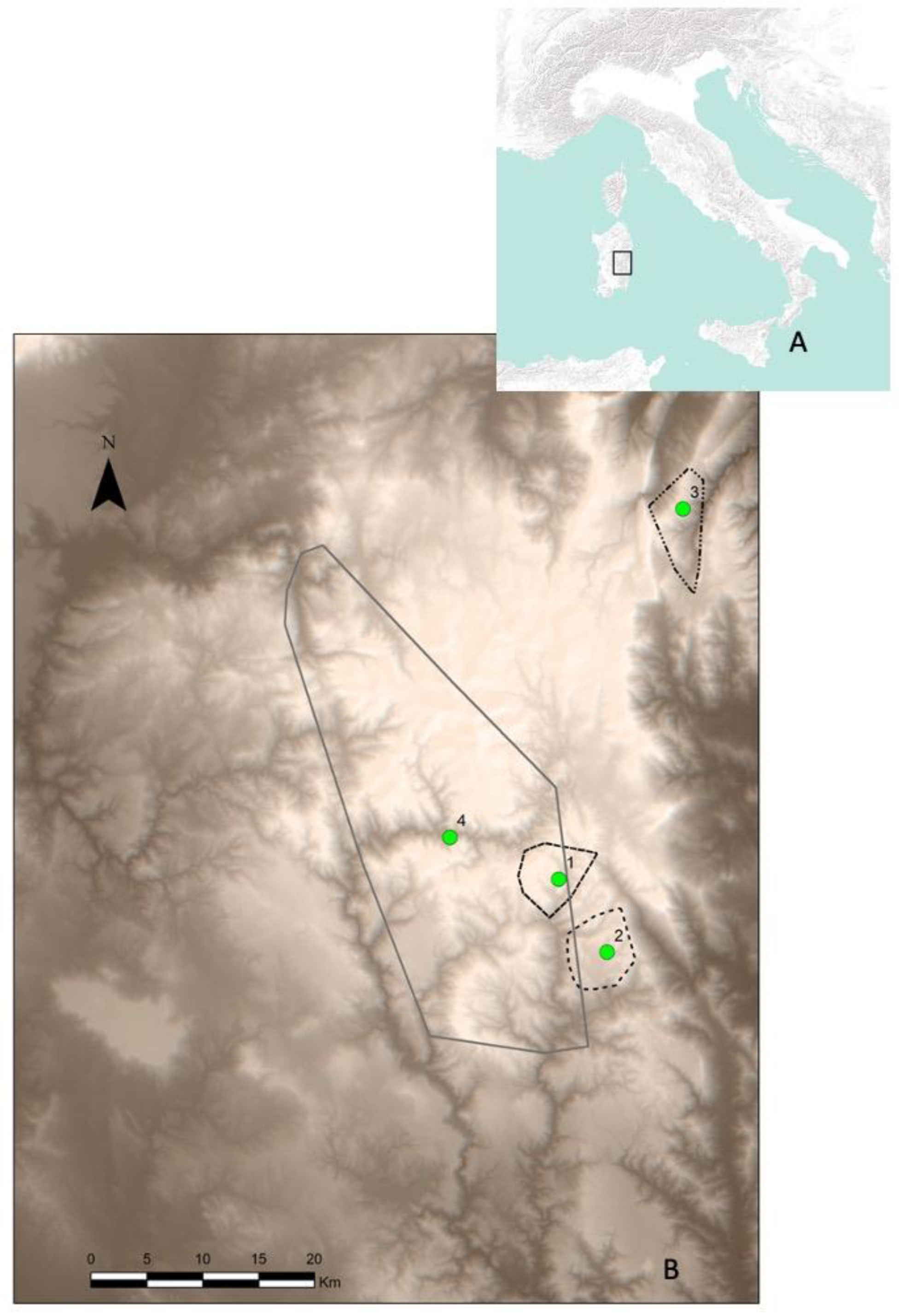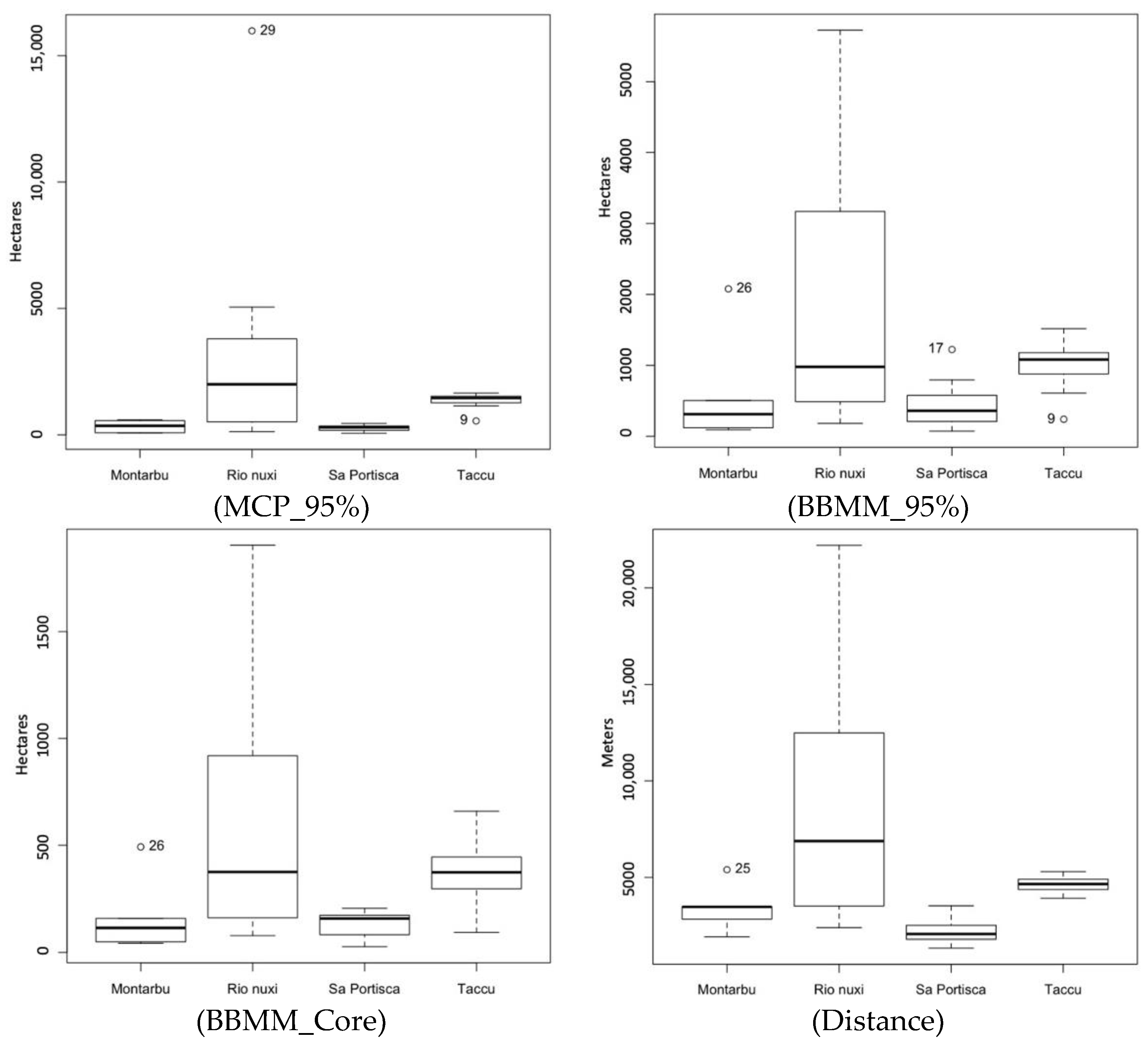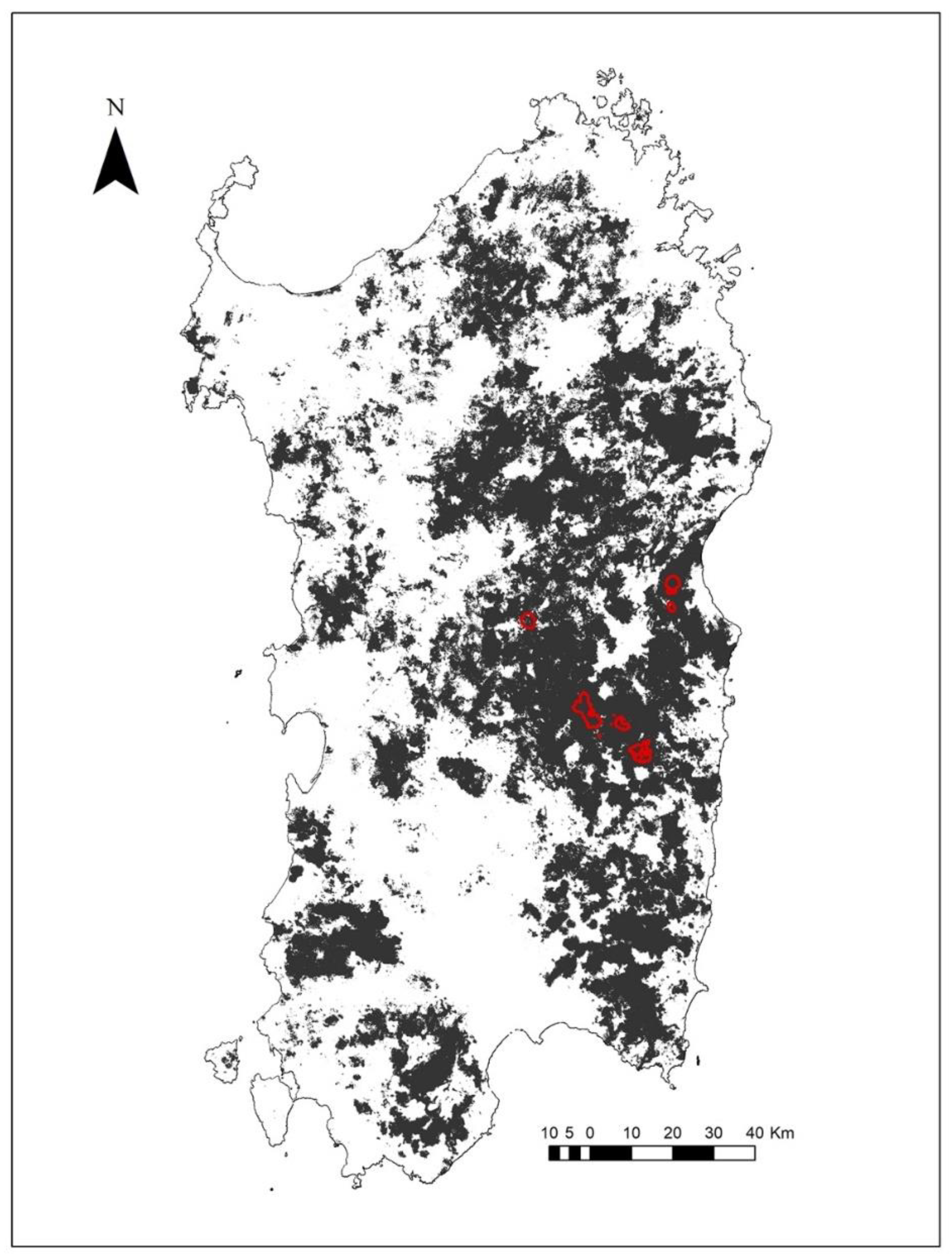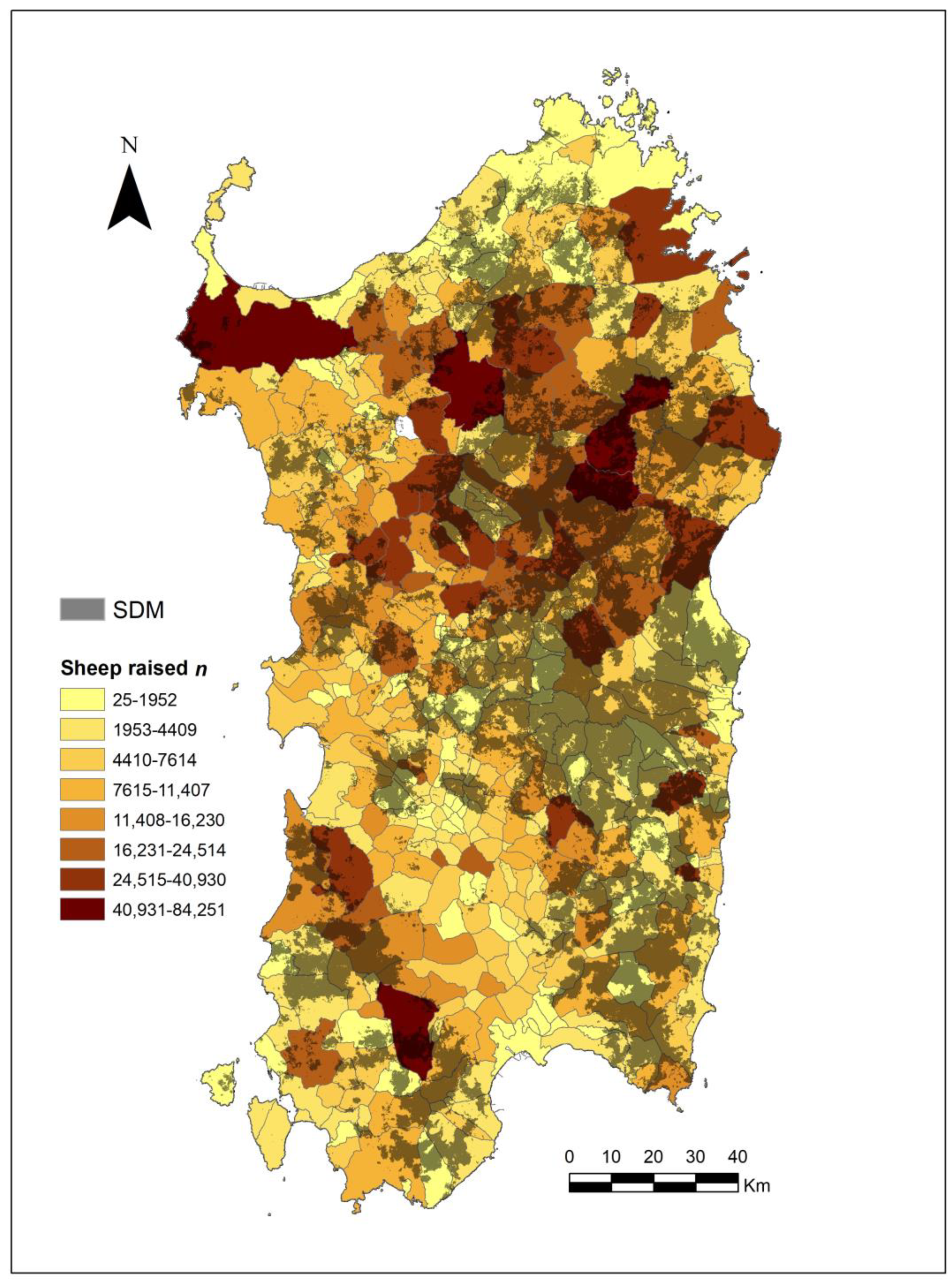Reintroductions of the Corsican Red Deer (Cervus elaphus corsicanus): Conservation Projects and Sanitary Risk
Abstract
Simple Summary
Abstract
1. Introduction
2. Materials and Methods
2.1. Study Area and Founder Populations
- Montarbu (39.855852, 9.387882) is located at an altitude between 600 and 1350 m above sea level (a.s.l.). In this area, Mediterranean holm oak (Quercus ilex L.) forest is predominant but alternates with Mediterranean scrub and garigue in open areas. Eight deer were released (4 males and 4 females), all coming from the fenced area.
- Taccu (39.812584, 9.456521) is at an altitude between 700 and 1000 m a.s.l., with alternation among holm oak wood and reforestation of conifers (Pinus spp.) and Mediterranean scrub. Twenty-two animals were released (8 males, 14 females), among which 12 originated from the fenced area of Montarbu and the others from the Costa Verde wild population.
- Sa Portisca (40.172065, 9.528568) is located at an altitude between 300 and 1000 m a.s.l. There is a predominance of holm oak (Quercus ilex) and juniper (Junipers spp.); the shrub layer is characterized by Pistacia lentiscus, Rhamnus alaternus, Phillyrea latifolia, Erica arborea, and Arbutus unedo. In this area, 41 deer were released, with 17 coming from the wild population of Costa Verde (3 males and 14 females) and 24 from the Sa Portisca rearing compound (13 males and 11 females).
- Rio Nuxi (40.185772, 9.545929) is located in the most important Sardinian mountainous area (Gennargentu) and is up to 1800 m a.s.l.; predominant habitat is wooded matorral with Juniperus spp. and Mediterranean shrubs with spiny brooms (Calycotome spinosa). Thirty-six deer (13 males and 23 females) captured in the Costa Verde area were released here.
2.2. Radiotelemetry
2.3. Suitability Model
2.3.1. Tracked Animal Data
2.3.2. Environmental Variables
2.3.3. Modeling Procedures
2.4. Deer Health Monitoring
3. Results
3.1. Reintroduced and Tracked Deer
3.2. Spatial Behavior
3.3. Species Distribution Model
3.4. Health Monitoring
4. Discussion
5. Conclusions
Author Contributions
Funding
Institutional Review Board Statement
Informed Consent Statement
Data Availability Statement
Acknowledgments
Conflicts of Interest
References
- IUCN. Guidelines for Reintroductions and Other Conservation Translocations; IUCN Species Survival Commission: Gland, Switzerland, 2013. [Google Scholar]
- Griffith, B.; Scott, J.M.; Carpenter, J.W.; Reed, C. Translocation as a species conservation tool: Status and strategy. Science 1989, 245, 477–480. [Google Scholar] [CrossRef] [PubMed]
- Witzenberger, K.A.; Hochkirch, A. Ex situ conservation genetics: A review of molecular studies on the genetic consequences of captive breeding programmes for endangered animal species. Biodivers. Conserv. 2011, 20, 1843–1861. [Google Scholar] [CrossRef]
- Berger-Tal, O.; Bar-David, S.; Saltz, D. Effectiveness of multiple release sites in reintroduction of Persian fallow deer. Conserv. Biol. 2012, 26, 107–115. [Google Scholar] [CrossRef] [PubMed]
- Jones, M.L.; Mathews, N.E.; Porter, W.F. Influence of social organization on dispersal and survival of translocated female white-tailed deer. Wildl. Soc. Bull. 1997, 25, 272–278. [Google Scholar]
- Jiang, Z.; Yu, C.; Feng, Z.; Zhang, L.; Xia, J.; Ding, Y.; Lindsay, N. Reintroduction and recovery of Père David’s deer in China. Wildl. Soc. Bull. 2000, 28, 681–687. [Google Scholar]
- Valente, A.; Valente, J.; Fonseca, C.; Torres, R. The success of species reintroductions: A case study of red deer in Portugal two decades after reintroduction. Int. J. Biodivers. Sci. Ecosyst. Serv. Manag. 2017, 13, 134–138. [Google Scholar] [CrossRef]
- Fischer, J.; Lindenmayer, D.B. An assessment of the published results of animal relocations. Biol. Conserv. 2000, 96, 1–11. [Google Scholar] [CrossRef]
- Ryckman, M.J.; Rosatte, R.C.; McIntosh, T.; Hamr, J.; Jenkins, D. Postrelease dispersal of reintroduced elk (Cervus elaphus) in Ontario, Canada. Restor. Ecol. 2010, 18, 173–180. [Google Scholar] [CrossRef]
- Yott, A.; Rosatte, R.; Schaefer, J.A.; Hamr, J.; Fryxell, J. Movement and spread of a founding population of reintroduced elk (Cervus elaphus) in Ontario, Canada. Restor. Ecol. 2011, 19, 70–77. [Google Scholar] [CrossRef]
- La Morgia, V.; Malenotti, E.; Badino, G.; Bona, F. Where do we go from here? Dispersal simulations shed light on the role of landscape structure in determining animal redistribution after reintroduction. Landsc. Ecol. 2011, 26, 969–981. [Google Scholar]
- Dieckmann, U.; O’Hara, B.; Weisser, W. The evolutionary ecology of dispersal. Trends Ecol. Evol. 1999, 14, 88–90. [Google Scholar] [CrossRef]
- Fautley, R.; Coulson, T.; Savolainen, V. A comparative analysis of the factors promoting deer invasion. Biol. Invasions 2012, 14, 2271–2281. [Google Scholar] [CrossRef]
- Berger-Tal, O.; Saltz, D. Using the movement patterns of reintroduced animals to improve reintroduction success. Curr. Zool. 2014, 60, 515–526. [Google Scholar] [CrossRef]
- Zidon, R.; Saltz, D.; Shore, L.S.; Motro, U. Behavioral changes, stress, and survival following reintroduction of Persian fallow deer from two breeding facilities. Conserv. Biol. 2009, 23, 1026–1035. [Google Scholar] [CrossRef] [PubMed]
- Calenge, C.; Maillard, D.; Invernia, N.; Gaudin, J.C. Reintroduction of roe deer Capreolus capreolus into a Mediterranean habitat: Female mortality and dispersion. Wildl. Biol. 2005, 11, 153–161. [Google Scholar] [CrossRef]
- Hajji, G.M.; Charfi-Cheikrouha, F.; Lorenzini, R.; Vigne, J.D.; Hartl, G.B.; Zachos, F.E. Phylogeography and founder effect of the endangered Corsican red deer (Cervus elaphus corsicanus). Biodivers. Conserv. 2008, 17, 659–673. [Google Scholar] [CrossRef]
- Mandas, L.; Mondoloni, S.; Murgia, A.; Riga, F. Current status, distribution and recovery plan of Cervus elaphus corsicanus. In Proceedings of the 33th International Union of Game Biologist Congress, Montpellier, France, 22–25 August 2017. [Google Scholar]
- Mattioli, S.; Meneguz, P.G.; Brugnoli, A.; Nicoloso, S. Red deer in Italy: Recent changes in range and numbers. Hystrix Ital. J. Mammal. 2001, 12, 27–53. [Google Scholar]
- Carnevali, L.; Pedrotti, L.; Riga, F.; Toso, S. Banca Dati Ungulati: Status, Distribuzione, Consistenza, Gestione e Prelievo Venatorio Delle Popolazioni di Ungulati in Italia: Rapporto 2001–2005; Istituto Superiore per la Protezione e la Ricerca Ambientale: Roma, Italy, 2009.
- Kidjo, N.; Feracci, G.; Bideau, E.; Gonzalez, G.; Mattéi, C.; Marchand, B.; Aulagnier, S. Extirpation and reintroduction of the Corsican red deer Cervus elaphus corsicanus in Corsica. Oryx 2007, 41, 488–494. [Google Scholar] [CrossRef][Green Version]
- Rondinini, C.; Battistoni, A.; Peronace, V.; Teofili, C. Lista Rossa IUCN dei Vertebrati Italiani; IUCN: Gland, Switzerland, 2013. [Google Scholar]
- Lovari, S.; Lorenzini, R.; Masseti, M.; Pereladova, O.; Carden, R.F.; Brook, S.M.; Mattioli, S. Cervus elaphus. The IUCN Red List of Threatened Species. 2018. Available online: https://www.iucnredlist.org/species/55997072/142404453, (accessed on 16 March 2020).
- Kock, R.A.; Woodford, M.H.; Rossiter, P.B. Disease risks associated with the translocation of wildlife. Rev. Sci. Tech. 2010, 29, 329. [Google Scholar] [CrossRef]
- Calistri, P.; Giovannini, A.; Conte, A.; Nannini, D.; Santucci, U.; Patta, C.; Rolesu, S.; Caporale, V. Bluetongue in Italy: Part I. Vet. Ital. 2004, 40, 243–251. [Google Scholar]
- Maan, N.S.; Maan, S.; Belaganahalli, M.N.; Ostlund, E.N.; Johnson, D.J.; Nomikou, K.; Mertens, P.P.C. Identification and differentiation of the twenty six bluetongue virus serotypes by RT–PCR amplification of the serotype-specific genome segment 2. PLoS ONE 2012, 7, e32601. [Google Scholar] [CrossRef] [PubMed]
- Commission, E. Blue Tongue. Available online: https://ec.europa.eu/food/animals/animal-diseases/surveillance-eradication-programmes-and-disease-free-status/bluetongue_en (accessed on 10 February 2022).
- García-Bocanegra, I.; Arenas-Montes, A.; Lorca-Orá, C.; Pujols, J.; González, M.; Napp, S.; Gámez-Guillamán, F.; Zorrilla, I.; Miguel, E.; Arenas, A. Role of wild ruminants in the epidemiology of bluetongue virus serotypes 1, 4 and 8 in Spain. Vet. Res. 2011, 42, 1–7. [Google Scholar] [CrossRef]
- Loi, F.; Laddomada, A.; Coccollone, A.; Marrocu, E.; Piseddu, T.; Masala, G.; Bandino, E.; Cappai, S.; Rolesu, S. Correction: Socio-economic factors as indicators for various animal diseases in Sardinia. PLoS ONE 2019, 14, e0217367. [Google Scholar] [CrossRef] [PubMed]
- Cappai, S.; Loi, F.; Coccollone, A.; Contu, M.; Capece, P.; Fiori, M.; Canu, S.; Foxi, C.; Rolesu, S. Retrospective analysis of Bluetongue farm risk profile definition, based on biology, farm management practices and climatic data. Prev. Vet. Med. 2018, 155, 75–85. [Google Scholar] [CrossRef] [PubMed]
- Muller, L.I.; Osborn, D.A.; Ramsay, E.C.; Doherty, T.; Miller, B.F.; Warren, R.J.; Miller, K.V. Use of xylazine/ketamine or medetomidine combined with either ketamine, ketamine/butorphanol, or ketamine/telazol for immobilization of White-tailed Deer (Odocoileus virginianus). J. Anim. Vet. Adv. 2007, 6, 435–440. [Google Scholar]
- Puddu, G.; Maiorano, L.; Falcucci, A.; Corsi, F.; Boitani, L. Spatial-explicit assessment of current and future conservation options for the endangered Corsican Red Deer (Cervus elaphus corsicanus) in Sardinia. Biodivers. Conserv. 2009, 18, 2001–2016. [Google Scholar] [CrossRef]
- Horne, J.S.; Garton, E.O.; Sager-Fradkin, K.A. Correcting home-range models for observation bias. J. Wildl. Manag. 2007, 71, 996–1001. [Google Scholar] [CrossRef]
- Aragno, P.; Riga, F. Valutazione Dell’efficienza dei Collari GPS-GSM, 25–27 June 2008; ISPRA: Ulassai, Italy, 2008.
- D’Eon, R.G.; Delparte, D. Effects of radio-collar position and orientation on GPS radio-collar performance, and the implications of PDOP in data screening. J. Appl. Ecol. 2005, 42, 383–388. [Google Scholar] [CrossRef]
- Karns, G.R.; Lancia, R.A.; DePerno, C.S.; Conner, M.C. Investigation of adult male white-tailed deer excursions outside their home range. Southeast. Nat. 2011, 10, 39–52. [Google Scholar] [CrossRef]
- Lewis, J.S.; Rachlow, J.L.; Garton, E.O.; Vierling, L.A. Effects of habitat on GPS collar performance: Using data screening to reduce location error. J. Appl. Ecol. 2007, 44, 663–671. [Google Scholar] [CrossRef]
- Team, R.C. R: A Language and Environment for Statistical Computing; R Foundation for Statistical Computing: Vienna, Austria, 2017; Available online: https:www.R-project-org/ (accessed on 16 December 2020).
- Michener, G.R. Spatial relationships and social organization of adult Richardson’s ground squirrels. Can. J. Zool. 1979, 57, 125–139. [Google Scholar] [CrossRef]
- Calenge, C. Home Range Estimation in R: The AdehabitatHR Package; Office National de la Classe et de la Faune Sauvage: Auffargis, France, 2011.
- Walter, W.D.; Fischer, J.W.; Baruch-Mordo, S.; VerCauteren, K.C. What is the proper method to delineate home range of an animal using today’s advanced GPS telemetry systems: The initial step. Mod. Telem. 2011, 68, 249–268. [Google Scholar]
- De Angelis, D.; Huber, D.; Reljic, S.; Ciucci, P.; Kusak, J. Factors affecting the home range of Dinaric-Pindos brown bears. J. Mammal. 2021, 102, 481–493. [Google Scholar] [CrossRef]
- Vander Wal, E.; Rodgers, A.R. An individual-based quantitative approach for delineating core areas of animal space use. Ecol. Modell. 2012, 224, 48–53. [Google Scholar] [CrossRef]
- QGIS.org. QGIS Geographic Information System. 2022 QGIS Association. Available online: https://www.qgis.org (accessed on 16 December 2020).
- Phillips, S.J.; Dudík, M. Modeling of species distributions with Maxent: New extensions and a comprehensive evaluation. Ecography 2008, 31, 161–175. [Google Scholar] [CrossRef]
- Beccu, E. Il Cervo Sardo; Delfino: Sassari, Italy, 1989. [Google Scholar]
- Lovari, S.; Cuccus, P.; Murgia, A.; Murgia, C.; Soi, F.; Plantamura, G. Space use, habitat selection and browsing effects of red deer in Sardinia. Ital. J. Zool. 2007, 74, 179–189. [Google Scholar] [CrossRef]
- Casula, P.; Murgia, A. Selectivity and context dependence of Corsican red deer browsing in a Mediterranean coppice system. Hystrix 2017, 28, 157–164. [Google Scholar]
- Vogt, P.; Riitters, K.H.; Estreguil, C.; Kozak, J.; Wade, T.G.; Wickham, J.D. Mapping spatial patterns with morphological image processing. Landsc. Ecol. 2007, 22, 171–177. [Google Scholar] [CrossRef]
- Vogt, P.; Riitters, K. GuidosToolbox: Universal digital image object analysis. Eur. J. Remote Sens. 2017, 50, 352–361. [Google Scholar] [CrossRef]
- Loy, A.; Aloise, G.; Ancillotto, L.; Angelici, F.M.; Bertolino, S.; Capizzi, D.; Castiglia, R.; Colangelo, P.; Contoli, L.; Cozzi, B.; et al. Mammals of Italy: An annotated checklist. Hystrix 2019, 30, 87–106. [Google Scholar]
- Pearson, R.G.; Raxworthy, C.J.; Nakamura, M.; Townsend Peterson, A. Predicting species distributions from small numbers of occurrence records: A test case using cryptic geckos in Madagascar. J. Biogeogr. 2007, 34, 102–117. [Google Scholar] [CrossRef]
- Patton, J.F.; Work, T.M.; Jessup, D.A.; Hietala, S.K.; Oliver, M.N.; Maclachlan, N.J. Serologic detection of Bluetongue Virus Infection of blacktailed deer: Comparison of serum neutralization, Agar Gel Immunodiffusion, and Competitive ELISA Assays. J. Wildl. Dis. 1994, 30, 99–102. [Google Scholar] [CrossRef] [PubMed][Green Version]
- Carranza, J.; de Trucios, S.J.H.; Medina, R.; Valencia, J.; Delgado, J. Space use by red deer in a Mediterranean ecosystem as determined by radio-tracking. Appl. Anim. Behav. Sci. 1991, 30, 363–371. [Google Scholar] [CrossRef]
- Kamler, J.F.; Jȩdrzejewski, W.; Jȩdrzejewska, B. Home ranges of red deer in a European old-growth forest. Am. Midl. Nat. 2008, 159, 75–82. [Google Scholar] [CrossRef]
- Catt, D.C.; Staines, B.W. Home range use and habitat selection by Red deer (Cervus elaphus) in a Sitka spruce plantation as determined by radio-tracking. J. Zool. 1987, 211, 681–693. [Google Scholar] [CrossRef]
- Gillich, B.; Michler, F.U.; Stolter, C.; Rieger, S. Differences in social-space–time behaviour of two red deer herds (Cervus elaphus). Acta Ethol. 2021, 24, 185–195. [Google Scholar] [CrossRef]
- Maor-Cohen, M.; Bar-David, S.; Dolev, A.; Berger-Tal, O.; Saltz, D.; Spiegel, O. Setting in: Reintroduction Persian fallow deer adjust the borders and habitats of their home range during the first 5 years post release. Front. Conserv. Sci. 2021, 2, 733703. [Google Scholar] [CrossRef]
- McDougall, P.T.; Réale, D.; Sol, D.; Reader, S.M. Wildlife conservation and animal temperament: Causes and consequences of evolutionary change for captive, reintroduced, and wild populations. Anim. Conserv. 2006, 9, 39–48. [Google Scholar] [CrossRef]
- De Azevedo, C.S.; Young, R.J. Animal personality and conservation: Basics for inspiring new research. Animals 2021, 11, 1019. [Google Scholar] [CrossRef]
- Niedbalski, W. Bluetongue in Europe and the role of wildlife in the epidemiology of disease. Pol. J. Vet. Sci. 2015, 18, 455–461. [Google Scholar] [CrossRef] [PubMed]
- Murray, J.O.; Trainer, D.O. Bluetongue virus in North American elk. J. Wildl. Dis. 1970, 6, 144–148. [Google Scholar] [CrossRef] [PubMed]
- Laore. Dati Sull’allevamento Ovino, Caprino E Bovino in Sardegna. 2019 Laore Agenzia Regionale per llo Sviluppo in Agrucoltura. Available online: https://www.sardegnaagricoltura.it/documenti/14_43_20200904094410.pdf (accessed on 20 January 2022).
- Loi, F.; Berzolari, F.G.; Laddomada, A.; Coccollone, A.; Scrugli, A.; Ghironi, A.; Putzolu, A.; Cappai, S.; Rolesu, S. Predictors of Bluetongue development in Sardinia (Italy) identification, using multilevel logistic mixed model. Epidemiol. Biostat. Public Health 2017, 14. [Google Scholar] [CrossRef]
- Casula, P.; Masci, A.; Mandas, L.; Fleba, L.; Secci, D. Cost-benefit analysis of red deer conservation in Sardinia. In Proceedings of the Buenos Aires: XIII World Forestry Congress, Buenos Aires, Argentina, 18–23 October 2009. [Google Scholar]




| Deer | Sex | Age Class | RS | RD | RtDs | Origin |
|---|---|---|---|---|---|---|
| F01 | F | AD | 2 | 03/02/09 | 775 | Captivity |
| F02 | F | SA | 2 | 14/02/09 | 653 | Captivity |
| F04 | F | SA | 2 | 14/02/09 | 623 | Captivity |
| F05 | F | AD | 2 | 14/02/09 | 507 | Captivity |
| F07 | F | SA | 1 | 26/02/09 | 593 | Captivity |
| F08 | F | AD | 1 | 26/02/09 | 568 | Captivity |
| F12 | F | SA | 2 | 21/10/09 | 506 | Wild |
| F13 | F | AD | 2 | 21/10/09 | 517 | Wild |
| F14 | F | AD | 2 | 23/11/09 | 791 | Wild |
| F17 | F | AD | 2 | 09/02/10 | 407 | Wild |
| F23 | F | AD | 3 | 06/02/14 | 578 | Captivity |
| F24 | F | AD | 3 | 06/02/14 | 509 | Captivity |
| F30 | F | AD | 3 | 25/02/14 | 363 | Wild |
| F41 | F | AD | 3 | 14/10/14 | 739 | Wild |
| F42 | F | AD | 3 | 14/10/14 | 756 | Wild |
| F43 | F | AD | 3 | 14/10/14 | 780 | Wild |
| F54 | F | AD | 4 | 20/03/15 | 406 | Wild |
| F55 | F | SA | 4 | 20/03/15 | 575 | Wild |
| F56 | F | SA | 4 | 20/03/15 | 435 | Wild |
| F64 | F | AD | 4 | 08/10/17 | 307 | Wild |
| M01 | M | AD | 2 | 03/02/09 | 328 | Captivity |
| M02 | M | AD | 2 | 03/02/09 | 584 | Captivity |
| M04 | M | AD | 2 | 14/02/09 | 453 | Captivity |
| M06 | M | SA | 1 | 26/02/09 | 458 | Captivity |
| M07 | M | SA | 1 | 26/02/09 | 300 | Captivity |
| M08 | M | SA | 1 | 26/02/09 | 551 | Captivity |
| M09 | M | AD | 1 | 26/02/09 | 578 | Captivity |
| M25 | M | AD | 3 | 06/02/14 | 604 | Captivity |
| M38 | M | AD | 4 | 26/01/15 | 494 | Wild |
| M40 | M | SA | 4 | 19/10/15 | 350 | Wild |
| M43 | M | AD | 4 | 05/10/16 | 705 | Wild |
| M48 | M | SA | 4 | 21/11/17 | 280 | Wild |
| Deer | MCP 95% ha | BBMM 95% ha | BBMM Core ha | Distance m |
|---|---|---|---|---|
| M01 | 1198.00 | 985.38 | 353.89 | 4145.39 |
| F01 | 1456.14 | 608.04 | 194.20 | 4901.29 |
| F02 | 1652.16 | 1092.61 | 366.77 | 5186.05 |
| F04 | 1620.34 | 1082.27 | 399.19 | 4658.35 |
| F05 | 1467.32 | 773.39 | 239.00 | 5300.74 |
| F07 | 71.09 | 94.13 | 42.81 | 1923.29 |
| F08 | 85.00 | 120.46 | 49.38 | 3487.63 |
| F12 | 1337.00 | 1308.25 | 515.53 | 4349.33 |
| F13 | 551.10 | 240.28 | 92.05 | 3920.92 |
| F14 | 1554.32 | 994.45 | 373.28 | 4399.98 |
| F17 | 1505.09 | 1517.29 | 659.45 | 4925.00 |
| F23 | 65.23 | 73.23 | 27.00 | 1358.76 |
| F24 | 74.08 | 131.10 | 57.33 | 1948.60 |
| F30 | 453.12 | 796.77 | 204.58 | 2724.17 |
| F41 | 294.79 | 360.09 | 179.03 | 3539.33 |
| F42 | 302.29 | 360.49 | 165.52 | 2071.96 |
| F43 | 407.75 | 1223.86 | 157.26 | 1676.28 |
| F54 | 128.71 | 183.93 | 76.88 | 2654.39 |
| F55 | 2534.08 | 1086.20 | 373.74 | 5709.06 |
| F56 | 2418.75 | 872.86 | 376.55 | 9130.35 |
| F64 | 750.10 | 604.03 | 178.14 | 4394.00 |
| M02 | 1456.56 | 1098.90 | 417.62 | 4795.08 |
| M04 | 1147.55 | 1259.54 | 472.60 | 4577.46 |
| M06 | 191.04 | 237.73 | 87.90 | 3485.01 |
| M07 | 528.67 | 504.91 | 157.73 | 5402.08 |
| M08 | 592.51 | 2078.35 | 492.35 | 2842.40 |
| M09 | 563.05 | 386.80 | 138.47 | 3466.05 |
| M25 | 287.01 | 284.59 | 106.32 | 2331.00 |
| M38 | 15,985.53 | 4257.88 | 956.20 | 22,201.29 |
| M40 | 1583.92 | 2082.93 | 881.29 | 15,843.96 |
| M43 | 5057.67 | 5498.64 | 1903.89 | 8067.77 |
| M48 | 284.16 | 373.74 | 143.20 | 2399.46 |
| Variable | MCP 95% | BBMM 95% | BBMM Core | Distance |
|---|---|---|---|---|
| Sex | W = 105 p = 0.5778 | W = 77 p = 0.09854 | W = 83 p = 0.1576 | W = 95 p = 0.3456 |
| Age class | W = 93 p = 0.3886 | W = 95 p = 0.4335 | W = 93 p = 0.3886 | W = 86 p = 0.2544 |
| Release Site df = 3 | KW = 16.176 p = 0.0010 * | KW = 8.396 p = 0.0385 * | KW = 11.02 p = 0.0116 * | KW = 15.94 p = 0.0011 * |
| Origin | W = 90 p = 0.1596 | W = 86 p = 0.1188 | W = 84 p = 0.1016 | W = 104 p = 0.3809 |
| Variable | Percent Contribution | Permutation Importance |
|---|---|---|
| Distance form urban areas | 45.7 | 33.4 |
| Distance from core forest areas | 21.1 | 20.8 |
| Distance from principal roads | 12.3 | 12 |
| Distance from forest areas | 9 | 17.9 |
| Acclivity | 4 | 3 |
| Ecological variables | 3 | 3.4 |
| Diversity index | 2.4 | 6.6 |
| Forest fragmentation | 1.5 | 0.4 |
| Exposition | 0.7 | 0.9 |
| Distance from water streams | 0.3 | 1.5 |
Publisher’s Note: MDPI stays neutral with regard to jurisdictional claims in published maps and institutional affiliations. |
© 2022 by the authors. Licensee MDPI, Basel, Switzerland. This article is an open access article distributed under the terms and conditions of the Creative Commons Attribution (CC BY) license (https://creativecommons.org/licenses/by/4.0/).
Share and Cite
Riga, F.; Mandas, L.; Putzu, N.; Murgia, A. Reintroductions of the Corsican Red Deer (Cervus elaphus corsicanus): Conservation Projects and Sanitary Risk. Animals 2022, 12, 980. https://doi.org/10.3390/ani12080980
Riga F, Mandas L, Putzu N, Murgia A. Reintroductions of the Corsican Red Deer (Cervus elaphus corsicanus): Conservation Projects and Sanitary Risk. Animals. 2022; 12(8):980. https://doi.org/10.3390/ani12080980
Chicago/Turabian StyleRiga, Francesco, Luciano Mandas, Nicola Putzu, and Andrea Murgia. 2022. "Reintroductions of the Corsican Red Deer (Cervus elaphus corsicanus): Conservation Projects and Sanitary Risk" Animals 12, no. 8: 980. https://doi.org/10.3390/ani12080980
APA StyleRiga, F., Mandas, L., Putzu, N., & Murgia, A. (2022). Reintroductions of the Corsican Red Deer (Cervus elaphus corsicanus): Conservation Projects and Sanitary Risk. Animals, 12(8), 980. https://doi.org/10.3390/ani12080980






